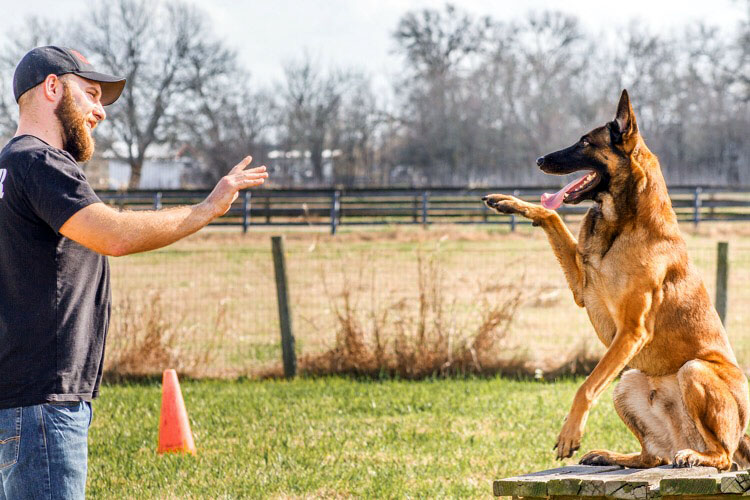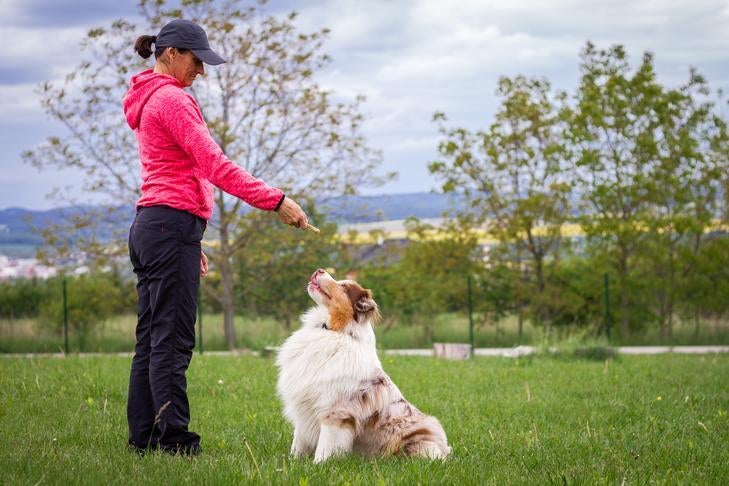The Importance of Patience and Understanding in Dog Training Practices
The Importance of Patience and Understanding in Dog Training Practices
Blog Article
Novice's Overview to Effective Pet Training in the house
Efficiently educating a canine at home calls for a nuanced understanding of canine actions and effective interaction techniques. Establishing clear training goals, making use of top quality benefits, and keeping uniformity across family members are important components. Incorporating training into day-to-day routines can improve both engagement and retention.
Understanding Canine Actions
Recognizing pet dog habits is important for efficient training and promoting a harmonious relationship in between humans and their canine companions. Dogs connect largely through body movement, vocalizations, and faces, making it important for proprietors to translate these signals accurately. Identifying actions such as tail wagging, grumbling, or cring can offer insights into a canine's psychological state and intentions.

Typical behavior concerns, such as hostility, anxiety, or too much barking, frequently come from misconceptions or unmet requirements. Observing and dealing with these problems quickly can protect against acceleration and make sure a favorable training experience. By cultivating a deep understanding of pet dog actions, owners can tailor their training approaches to fit their canine companions, inevitably leading to a satisfied and mannerly family pet.
Vital Training Tools
A well-equipped training area can substantially improve the efficiency of canine training in the house. Important training devices make certain that both the pet dog and the fitness instructor can involve in effective sessions that promote learning and bonding.

Purchasing a strong chain and a comfy, well-fitting collar or harness is important for security and control. These tools help establish borders and make certain the pet stays safe and secure during training. In addition, a marked training location, cost-free from diversions, help concentration for both the instructor and the pet.
Educating aids such as training pads, cones, or dexterity equipment can additionally boost the experience by introducing range and difficulties. Last but not least, having a note pad or electronic application for tracking progression can be important, allowing you to keep in mind successes and locations for renovation. Utilizing these important devices will produce a favorable training environment and lay the structure for efficient understanding.
Developing a Training Routine
Establishing a consistent training routine is essential for reliable pet dog training in the house. A well-structured routine not only assists in strengthening preferred actions but additionally gives your dog with a complacency and predictability. To create a reliable training routine, start by identifying particular training goals, such as fundamental commands, chain strolling, or house-breaking.
Choose a marked time each day for training sessions, preferably when your dog is responsive and sharp. Procedure ought to be brief, roughly 5 to 15 minutes, to maintain emphasis and avoid exhaustion. Consistency in timing and environment will certainly enhance your pet's understanding experience.
Include training right into day-to-day tasks to find more enhance abilities. Technique commands during walks or mealtime, which incorporates discovering right into natural regimens. Additionally, stay flexible and adjust the regular as required, suiting your canine's power levels and mood.
Favorable Reinforcement Techniques
Positive reinforcement strategies are essential to reliable dog training, promoting preferred actions through incentives instead of penalty. This method utilizes positive stimulations, such as deals with, appreciation, or playtime, to encourage pet dogs to repeat details actions. The cornerstone of this technique is timing; benefits should be offered immediately adhering to the preferred actions to create a clear organization.
When applying positive support, it is important to choose rewards that are encouraging for your dog. High-value treats, such as tiny pieces of hen or cheese, can be particularly reliable throughout training sessions. Furthermore, varying the incentives can maintain your pet's interest and enthusiasm.
Beginning with simple commands, like "sit" or "remain," and slowly progress to more complex tasks. Consistency is essential; ensure that all household members use the exact same commands and incentive systems to avoid confusion.
In addition, it is crucial to remain client and prevent disappointment. Dogs, like human beings, learn at their own speed. By promoting an encouraging training atmosphere via positive reinforcement, you can enhance your pet dog's learning experience while reference strengthening the bond in between you and your hairy friend, laying the foundation for effective training end results.
Usual Educating Challenges
While educating a canine in the house can be a fulfilling experience, it typically features a collection of typical obstacles that can test both perseverance and uniformity. One widespread problem is distraction. Pets might become quickly sidetracked by sounds, movements, and even aromas in their environment, making it hard to preserve their emphasis throughout training sessions.
One more difficulty is disparity in commands and support. If relative use different hints or benefits, it can confuse the pet and prevent progress. Developing a unified approach is essential for reliable communication.
In addition, pets can experience aggravation or tension, especially if they do not understand what is anticipated of them. This can cause undesirable behaviors, such as barking or eating.
Lastly, the timing of reinforcement is vital (Dog training). Delayed rewards can diminish the efficiency of favorable reinforcement, as dogs may fall short to connect the behavior with the reward
Conquering these challenges needs commitment, clear interaction, and an organized training plan. Identifying and attending to these usual obstacles will certainly lead the way for an extra successful and delightful training experience at home.
Verdict
In final thought, successful pet training at home requires a detailed understanding of canine actions and effective communication strategies. By developing clear training goals and making use of top notch treats along with favorable reinforcement, the training process ends up being extra rewarding for both the fitness instructor and the canine.
Establishing a regular training routine is crucial for efficient dog training at home.Positive reinforcement techniques are essential to click site reliable pet training, promoting desired behaviors via benefits instead than punishment (Dog training). By promoting a supportive training atmosphere via favorable support, you can boost your canine's discovering experience while strengthening the bond between you and your fuzzy companion, laying the groundwork for effective training results
In final thought, successful dog training at home requires a detailed understanding of canine actions and reliable communication strategies. By establishing clear training goals and making use of premium treats alongside favorable support, the training procedure becomes extra gratifying for both the instructor and the dog.
Report this page